| Aims:
1. What are the rules of
chess?
2. How is the chess board set up?
3. What strategies may be used in chess?
4. How are coordinates on a chess board labeled?
5. What are rules of chess etiquette? How can we apply
rules of etiquette in chess competition?
6. How can good sportsmanship be demonstrated as part of a
healthy competition within a cooperative learning environment?
Materials:
chess
sets |
computer with
Internet access |
Al Woolum, The
Chess Tactics Workbook, (North Richland
Hills, Tx 2000) |
MacEnulty,
Let's Play Chess!, A Kid's Guide To The
Royal Game, Chess-in-the-Schools,
(New York, 2001) |
Note to teachers: If The
Chess Tactics Workbook and Let's Play Chess!, A Kid's Guide To The Royal Game, are
not available, the online resources listed in this lesson
are most definitely sufficient resource material to carry out this unit with
your class.
Vocabulary:
Teachers may introduce vocabulary
words as they come up in context or students may
use Dictionary.com or Enchanted
Learning to define
the vocabulary words. Click here to see a glossary of words related to this chess unit.
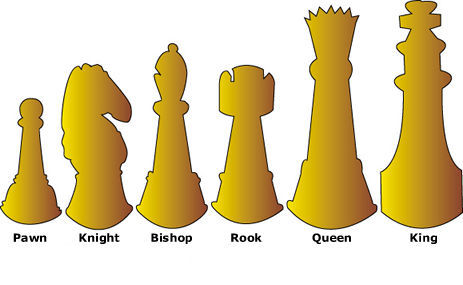
Motivation:
1. Students examine and
identify each chess piece. Students begin to think about why
each chess piece is configured as it is. (This would be a
prelude to Lessons 3 and 4 of this unit).
2. Students log onto these
interactive and instructional chess web sites: Chess4Kids, Chess Wave, The Basics of Chess, Omega Chess, Chess Basics, and/or read pages 2-13 in Let's
Play Chess!, A Kid's Guide To The Royal Game, to answer these questions:
1. How is a
chess board set up? |
The rooks are on the outermost
spaces. The knights stand beside the
rooks. Bishops come next. The queen
always starts on her own color. The white
queen begins on a light square and the
black queen begins on a dark square. The
kings stands next to the queen. Pawns go
on the row in front of the other pieces. |
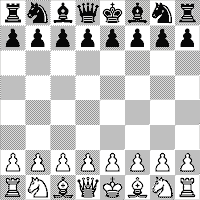 |
| 2. How is each space on the
chess board identified? |
Each space on the chess board is
named after the file and rank they are
on. Each space is named by a letter and a
number. Ranks go horizontally. They are
named from a through h. Files go
vertically. They are numbered from 1
through 8. Diagonals are rows of squares
at an angle. |
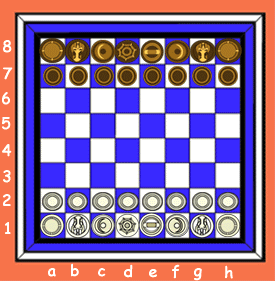
|
Click here to see blank charts for this lesson.
Development:
Continue to use the Chess Wave , Chess4kids, Chess Basics, and Let's Play
Chess!, A Kid's Guide To
The Royal Game, and The
Chess Tactics Workbook to answer the
questions on the chart. Students may position pieces and move
pieces on a chess board to model the diagrams shown on the chart
as they demonstrate to the class these moves to the class.
| 1. What is the object of the
game? |
The objective in chess is to place
your opponent's King in a position in
which he cannot escape being captured.
This is called checkmate and the games ends. If a King is placed
in a position in which he can be
captured, but he is able to escape, then
it is said to be in check. A King cannot
move into check, and if in check must
move out of check immediately. There are
three ways you may move out of check:
1.
Capture the checking piece,
2. Block the line of attack by
placing one of your own pieces between
the checking piece and the King. (Of
course, a Knight cannot be blocked.)
3. Move the King away from check |
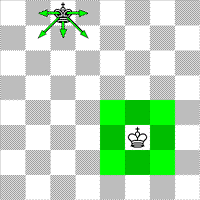
|
| 2. How does each chess piece
move? |
The  rook is the second most powerful
piece. It can move any number of spaces
up, down, left, or right. It can move to
any square along its file or row as long
as its path is not blocked. The rook has
a point value of 5. rook is the second most powerful
piece. It can move any number of spaces
up, down, left, or right. It can move to
any square along its file or row as long
as its path is not blocked. The rook has
a point value of 5.
The  bishop moves in straight
lines on diagonals. They can cross the
board in one move as long as no piece is
in its way. They can also stop anywhere
along the way. bishop moves in straight
lines on diagonals. They can cross the
board in one move as long as no piece is
in its way. They can also stop anywhere
along the way.
The bishop has a point value of 3.
The  queen moves in a straight line in ranks, files,
and diagonals. The queen is the most
powerful piece on the board, combining
the powers of the rook and bishop. She
may move any number of spaces in any
directions as long as her path is not
blocked. The queen has a point value of 9. queen moves in a straight line in ranks, files,
and diagonals. The queen is the most
powerful piece on the board, combining
the powers of the rook and bishop. She
may move any number of spaces in any
directions as long as her path is not
blocked. The queen has a point value of 9.
The  king may move only one square in a turn in any
direction. It can never move onto a
square that is under attack by any enemy
piece. If a king is in "check,"
he must get out of check immediately. If
there is no way for the king to get out
of check, the situation is called
"checkmate" and the game is
over. king may move only one square in a turn in any
direction. It can never move onto a
square that is under attack by any enemy
piece. If a king is in "check,"
he must get out of check immediately. If
there is no way for the king to get out
of check, the situation is called
"checkmate" and the game is
over.
The  knight is the only piece that may jump over
other pieces. It moves 5 spaces in an L
shape. At the beginning of the game when
many pieces are on the board, the
knight's ability to jump over pieces
makes it very valuable. The knight has a
point value of 3. knight is the only piece that may jump over
other pieces. It moves 5 spaces in an L
shape. At the beginning of the game when
many pieces are on the board, the
knight's ability to jump over pieces
makes it very valuable. The knight has a
point value of 3.
The 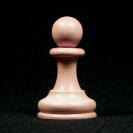 pawn is the least powerful piece.
It may move only one space forward if its
path is not blocked. On each pawn's first
move, it may move one or two spaces
forward. The pawn may not move backwards
but my move one space diagonally to
capture an opponents piece. The pawn has
a point value of 1. pawn is the least powerful piece.
It may move only one space forward if its
path is not blocked. On each pawn's first
move, it may move one or two spaces
forward. The pawn may not move backwards
but my move one space diagonally to
capture an opponents piece. The pawn has
a point value of 1.
- Note: the piece with the
higher point value can be used
more strategically.
|
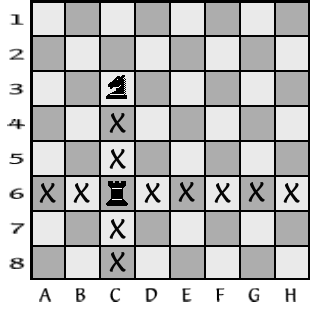
Rook Moves
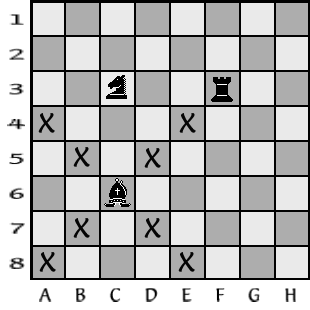
Bishop Moves
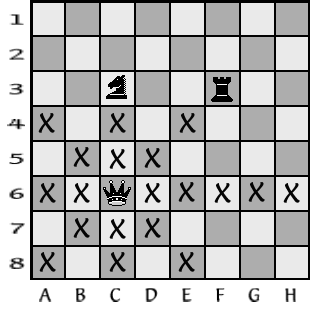
Queen moves
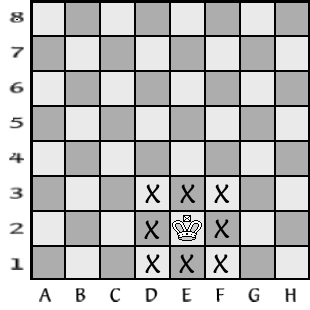
King moves
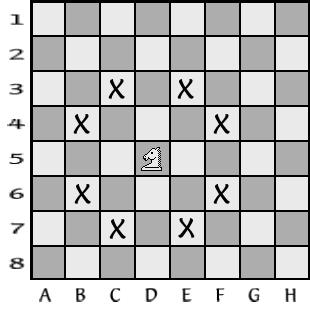
Knight Moves
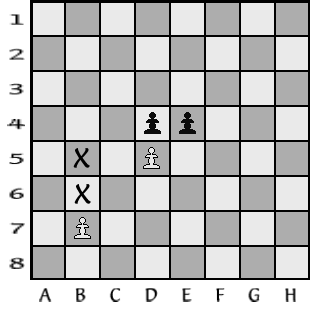
Pawn Moves |
| 3. What are some chess playing
rules? |
Chess is a two player game. The
White or player, or light colored piece,
moves first. Each player takes one turn.
No player may skip a turn. A player may
not move a piece to a square already
occupied by one of his own pieces. A
player may capture an opposing piece by
replacing that piece with one of his own
pieces. The piece that is captured is
removed from the board.
Draws:
If a King is not in check, and no other
legal move is possible, then the position
is said to be in stalemate. A stalemated
game is a draw, or a tie. If 50 moves are
made without any pawns being moved or the
capture of a piece, then a game is a
draw. If there are not enough pieces for
either side to checkmate, a draw may be
declared due to Insufficient mating
material. If both players agree to call
the game a draw, the game is over. If the
exact same position occurs 3 times in a
game, then a game can be a draw.
If you touch a piece and it can be
legally moved, then you must move it. |
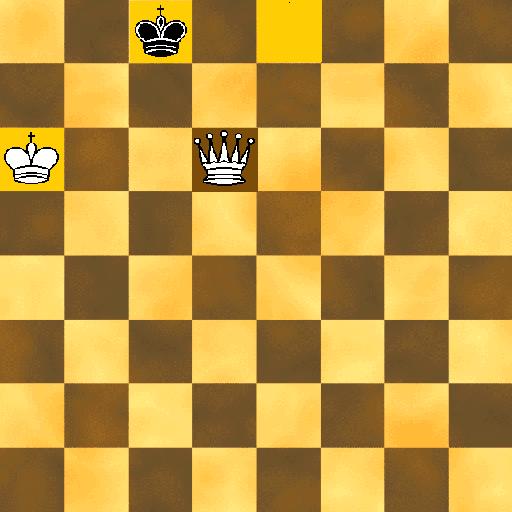
Stalemate |
| 4. What are some chess
strategies? |
- Move your pieces toward the
center by moving a center pawn so
your bishops and queen will be
able to move out. Bring out the
knights and bishops at the
beginning of the game to help
control the center. This is
called development.
- Try to move almost every piece
once before you move any piece
twice.
- Keep your king safe. Castling will help. Castling allows a
player to quickly move both the
King to safety and the Rook to
the center for battle. For this
reason, wise players carefully
guard their ability to castle and
usually castle early in the game.
Players should try to prevent
their opponent from castling. The
player moves his King two squares
toward one of the player's Rooks
and moves that Rook to the
opposite side of the King. A
player may not castle if either
the King or the Rook involved
have already moved. Also, the
King may not castle out of,
through, or into check. There
must be no pieces between the
King and Rook when castling.
- There are three ways to escape
from check. They are move to safety, block the attacker, and capture the attacker.
- Before you move, make sure
none of your pieces are in danger
of being captured.
- Make a plan. Think before you
move. Make your pieces work as a
team.
- Don't give up.
- Learn from your mistakes.
- If a pawn reaches the eighth
space, it may be substituted for
any other of the player's pieces
except for the king. This may
result in having two queens or
three rooks.
|
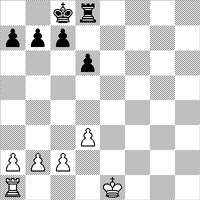
Castling |
| 5. How
do pieces attack and capture? |
Attack means a piece is in position and ready to
capture an opponent's piece on the next
move.
Capture means
to move a piece onto the square that is
occupied by an opponent's piece. The
opponent's piece is then removed from the
board and out of the game.
The Fork is a move in which one piece threatens
two other pieces in risk that one of the
pieces will be taken.
The Pin causes
one piece to be unable to be moved for
threat of the capture of an important
piece or the king.
The Skewer results
when the movement of one piece gives an
opportunity to capture another piece. |

The bishop is
forking the rook and the knight.

The rook has the
knight pinned because moving the knight
would put the king in check.
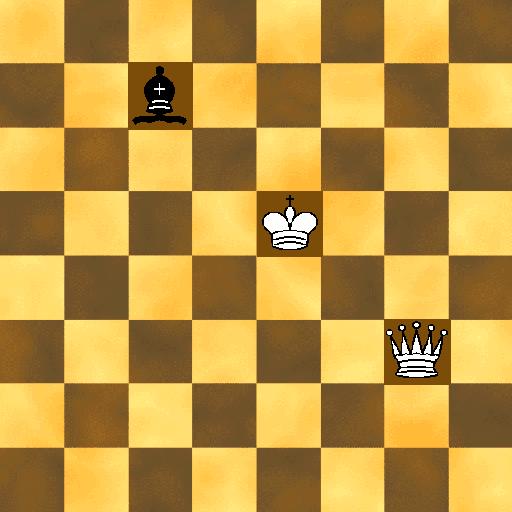
The bishop skewered
the king because the king is in check and
once the king is moved, the queen is
captured. |
| 6. What
are some rules for chess etiquette? |
- Practice good sportsmanship.
Always shake hands before the
game.
- Take turns
- Keep your hand off the board
and pieces if it is not your
turn.
- Take time to think before each
move, and be courteous during
your partner's think time.
- Never annoy your partner.
|
|
Summary:
1. Students read 54-55, "How
to Read and Write Chess" in Let's
Play chess! and/or Chess Notation.
2. Now that students understand the rules
of chess, they are ready to get hands on experience as they play chess. Click here to see us play. Online chess web sites for students
to get chess play experience include:
3.Students use the table of chess notation below to record the moves of their
game. Record in journal how they were check mated
or achieved a check mate. View a sample journal.
K
King
Q Queen
R Rook
B Bishop
N or Kt Knight
P Pawn
x captures
- moves to
+ or ch check
dis ch discovered check
++ or dbl ch double check
e.p. en passant (in passing)
! a good move
!! a very good move
? a bad move
?? a very bad move
!? not sure, but looks good
?! not sure, but looks bad
X or # checkmate
o-o castles kingside
o-o-o
castles queenside
------------------------------------------------------------------------ |
Evaluation:.
Students demonstrate their
understanding of chess strategies by solving Omega Chess Puzzles. These puzzles may be shown on a projection screen
via an LCD projector or redrawn on large wall charts. Students can then predict outcomes and explain
and demonstrate strategies in terms of cause and effect
relationships. The strategies taken and the
ability to recorded moves in students' journals
will be evaluated. See rubric.
Students may also describe in either oral or a written
essay why they enjoy playing the game of chess and what they
learn as a result of playing.
Follow Up:
Students may play chess on a human chess
board. Black and white oak tag may be set up on a gymnasium
floor to serve as the chess board or a chess board may be drawn
on sheets. Chess pieces may be drawn on oak tag worn front and
back (like sandwich signs) by students serving as playing pieces
to wear. The chess players call moves to the human chess pieces.
The chess pieces move to the space on the chess board that they
are instructed to.
A speaker and or
instructor may be invited in to address the class regarding
chess play. Chess In
The Schools is a not-for profit
educational organization dedicated to stimulating
and enhancing learning skills by teaching chess to kindergarten
through eighth grade children in New York's inner-city public
schools, in after-schools, with tournaments competitions, and
Alumni programs for high school students. Materials and an instructor are provided for the students
through Chess In The Schools. Other resources such as this may
be found in the locale of the students. These resources may
include family members, expert community chess players, local
chess clubs. Additional not-for-profit chess organizations that
may serve as resources for your students may be found at the Chessville.com.
Students might use
modeling clay or papier mache to craft their own chess pieces.
In Lesson 2 students will learn about the history of chess?
Additional
Resources:
1. "Chess Improves Children's Reading
Scores"
describes research that show when students play
chess, their reading scores improve.
2. Play online chess against
students in P.S. 166,
in Connecticut.
3. Chess Class is an instructional chess web site
that describes how to set up a chess club and
chess competition. |